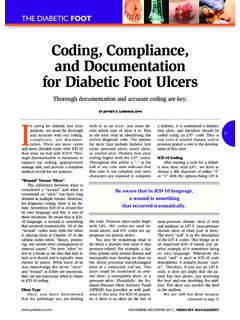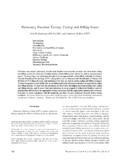Transcription of Documentation of The Top Ten CPT Codes, Part 1 Attention ...
1 Documentation of The Top Ten CPT Codes, Part 1. Attention to detail will enable you to receive proper payment. Kenneth F. Malkin, DPM. Dr. Malkin is a diplomate of the American Board of Quality Assurance and Utilization Review Physicians. He is immediate past president of the American College of Podiatric Medical Review and the Medicare Physicians Carrier Advisory Committee representative for New Jersey. Fear of Medicare audits and malpractice suits often drives physicians to write textbook chapters for each and every patient encounter. Unfortunately, writing a longer note does not guarantee that the required elements for an audit will be documented. Where are the rules the auditors use? There are four common reference sources that may be consulted to determine the requirements for the Documentation of medical services. The least obvious is each state medical licensing board. Each physician should maintain a copy of the rules and regulations of his/her state licensing board.
2 This manual will include the requirements for Documentation of patient encounters. These sources are usually overly general, but are the law in your state. The other main sources would be the AMA/Center for Medicare/Medicaid (CMS) Guidelines on Evaluation and Management Coding (E/M) from 1995 or 1997, your local medical review policies (LMRP) promulgated by your Medicare carrier for commonly billed procedural codes, and commercial third-party payer guidelines. Documentation is often related to coding but differs in its sources. Obviously the Gray's Anatomy of coding is the AMA CPT Manual. However, the guidelines contained in the manual are sparse. Table 1 lists the top ten CPT codes billed to Medicare by podiatrists in 2000 listed in order of frequency. This information is supplied courtesy of the American Podiatric Medical Association. Since these ten codes represent 64% of all codes billed by DPM's to Medicare, it follows that knowing the rules for these codes brings you two thirds of the way towards perfection.
3 Seven of the services are surgical procedures and three are Evaluation and Management (E/M). services. Table 1. Top 10 CPT Code By Frequency Billed To Medicare in 2000. 1. 11721. 6. 11719. 2. 99212. 7. 11056. 3. 99213. 8. 11730. 4. 11720. 9. 99202. 5. 11040. 10. G0127. General Guidelines 1. Each page of the medical record must contain the patient's name and date of service. 2. The note must be legible. If your nurse cannot read your handwriting, you must buy a computerized charting program or utilize a dictation service. 3. Each day of service should be self-contained and support a medically necessary service. 4. If the service is an E/M service, the code level chosen must meet the guidelines of Center for Medicare/Medicaid Services (CMS) /American Medical Association (AMA) Guidelines for 1995 or 1997. 5. If the service is a procedure, and the procedure has a Medicare local medical review policy (LMRP), it must follow the guidelines in place at the time the service was performed.
4 If the procedure is for a non-Medicare patient or there is no LMRP or third party payer policy for the procedure, the Documentation must follow the standards set by peers in the community. LMRP's It follows that a prudent physician would either commit to memory or have available for ready reference the key points contained in local medical review policy (LMRP) for the services that are billed in the practice. LMRP's are published on the internet on each Medicare Carrier's web site and also published in written bulletins mailed to every physician at the address listed for receipt of their payments . Top-Ranked Codes 1 and 4: CPT 11720 and 11721. These two codes are discussed together for obvious reasons. Requirements differ only by the number of nails treated (less than five for 11720 and six or more for 11721). Documentation requirements are variable for these codes and are based on the LMRP's maintained by each Medicare carrier.
5 These codes are under severe scrutiny and the OIG recommends Focused Medical Reviews be conducted by carriers in the coming year. Using the SOAP format for all Documentation is prudent, but not required. Subjective 1. Describe the office or specific location in which the patient is being examined and treated. 2. Document any symptoms the patient may be experiencing or may have been experiencing. Some Medicare carriers require all patients billed with 11720 or 11721 to experience pain that markedly limits ambulation while other carriers require simply pain, and others require that no painful symptoms be documented - if the patient has a systemic disease that is severe enough it puts the patient at risk.. 3. Many states that require pain be present for eligible nail debridement also require thatthe specific nails, which are causing the patient pain, be documented. 4. There are no clear guidelines on documenting pain for patients who are unable to communicate verbally.
6 A prudent physician would document any physical actions the patient demonstrates upon palpation of his/her nails. Objective 1. Some states require clinical evidence of mycosis to be present, while others simply consider onychauxis or the thickening of a nail as eligibility for the nail debridement codes. It is required in most jurisdictions to describe the clinical appearance of at least one nail for 11720 and at least six nails for 11721. Some states have specific clinical descriptors that must be used to be eligible. Review your local medical review policy. Common clinical descriptors for onychomycosis include onycholysis, dystrophy, yellow white discoloration, odor, subungual debris. The use of the word thickness seems to be critical in many jurisdictions, as some carriers define nail debridement as being the reduction of thickness or girth of a nail.. 2. Some carriers allow debridement codes to be used in the absence of pain - if the patient suffers from a systemic disease that appears on a carrier's specific list with other supporting information.
7 If the diagnosis on the list carries an asterisk, most states require Documentation that the patient is under the active care of an MD or DO. Active care is usually defined as seeing an MD or DO. in the six months prior to treatment, but there are some exceptions. In most states, the diagnosis of vascular insufficiency (a diagnosis without an asterisk) may be made by a DPM, and in a few other states it requires an MD or DO. Usually the vascular insufficiency diagnoses do not require that the patient be under the active care of an MD or DO. In these cases, the treating DPM is considered the referring doctor for the purposes of claim submission. 3. In most cases, the systemic disease not only has to appear on the carrier's list, but also may have to be considered severe enough. The severity is presumed when the patient meets class-findings , which are generally elements of the vascular exam. If class findings are required for a patient, they should be documented and updated periodically.
8 4. In about one half of the states, diabetes is covered without class findings and hence considered a stand-alone diagnosis. This means the patient does not have to meet class-findings, but does have to be under the active care of an MD. or DO for diabetes and have documented in the medical record the loss of protective sensation or LOPS. 5. Lastly, there are some states that allow for nail debridement in the presence of a secondary infection resulting from a thickening of the nail plate, without requiring pain or a systemic disease. *If it is not obvious, you must be certain of all the requirements for nail debridement to be covered in your state . Assessment This would include onychomycosis or onychauxis (where eligible) and either pain that limits ambulation (if present and a qualifier) or a systemic disease on the list of the carrier (if a qualifier) or a secondary infection (again if considered a qualifier). Plan This should be specific to the patient, the exam and the day of service - , debridement of nails 123 left and 13 right to patient's tolerance was performed.
9 If any topical medication or oral therapy is prescribed, it should be documented. One note: some states do not allow 11720 or 11721 for nail debridement in the absence of pain but do allow the use of G0127 (trimming of dystrophic nails). for mycotic nails that are debrided in the absence of pain but with systemic disease that puts a patient at risk. Top Ranked Codes 2,3 and 9:CPT 99202, 99212, and 99213 The E/M Codes * The SOAP (subjective, objective, assessment, and plan) format is the most commonly used method for these notes. * Every E/M code is calculated based on the extent of the key components that are documented (history, exam, and decision making) or the time of counseling/. coordinating care. For the purposes of the following discussion the time of counseling or coordinating care is not being considered in determining the level of CPT code. * All E/M visits for established patients in an office or other outpatient setting require that two of three of the key components meet or exceed the level of code which is chosen.
10 Therefore, for example, if the level of history (problem- focused, expanded-problem focused, detailed, or complete) and level of decision-making (straightforward, low, moderate or high complexity) meet the level of code that is chosen, the level of exam component does not need to be considered. * All E/M encounters for new patients in an office or other outpatient setting require that three of three key components meet or exceed the level of CPT code which is chosen. * A CPT 99212 requires at least two of the following three be met: a problem- focused history, a problem-focused exam, and straightforward decision-making. * A CPT 99213 requires at least two of the following three be met: an expanded problem-focused history, an expanded problem-focused exam, and low-level decision-making * A CPT 99202 requires at least three of three of the following be met: an expanded problem-focused history, an expanded problem-focused exam, and straightforward decision-making.









